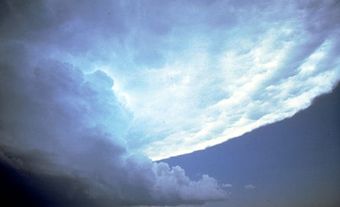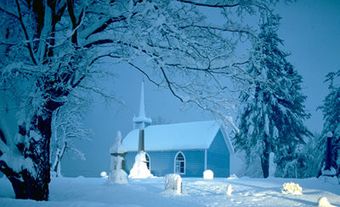Wind
Wind is the motion of air relative to the rotating surface of the Earth. Winds are caused by differences in atmospheric pressure: the greater the difference, the stronger the wind. The horizontal component of a wind is much greater than its vertical component; therefore, winds are usually thought of as moving horizontally. On a nonrotating Earth, air would move directly from areas of high pressure to those of lower pressure, ie, warm air would rise at the equator and flow poleward as cold polar air sank and flowed towards the equator. However, in Canada, as elsewhere in the Northern Hemisphere, winds are deflected to the right of the path of motion by the Coriolis effect, a force resulting from the Earth's rotation. This deflection produces the prevailing westerly winds.How We Get Bad and Good Weather
In the atmosphere, between about 1.2 and 1.6 km above the Earth's surface, winds tend to blow parallel to rather than across the lines of equal pressure (isobars). These winds, known as geostrophic winds [Gk geo, "earth," strophikos, "turned"], are balanced because they are acted upon equally by the horizontal pressure force and the horizontal Coriolis effect. Gradient winds have the same direction as geostrophic winds, but move more quickly in cyclonically curved, counterclockwise paths (low pressure areas), and more slowly in anticyclonically curved, clockwise paths (high pressure areas). Near the ground, friction reduces wind speed and deflects the wind towards lower pressure. Consequently, winds converge and lift in lows. The result is bad weather. In high pressure systems they diverge. The subsidence that accompanies divergence leads to clear weather.
Major Role
Winds play a major role in the heat and moisture balance of Canada. They pick up moisture from the oceans and lakes and distribute it across the country as precipitation. They transport heat from the oceans and from southerly latitudes into the interior and bring down cold air from the Arctic to the rest of the country and beyond. In Canada, wind speed is strongest in the North. Resolution Island, NWT, has the greatest average annual wind speed in the country (35.5 km/h). The average in the prairies is about 18 km/h, compared to 14 km/h for the rest of the country. Some of the strongest winds in the country are hurricanes and tornadoes. Regional and local winds occur in many parts of the country. Mountain and valley winds (downslope and upslope, respectively) are found in interior BC. CHINOOKS are warm, dry, gusty, foehn-type winds, ie, winds that blow down alpine valleys. They occur in southern Alberta.
In coastal areas and around the Great Lakes, sea/lake and land breezes occur, caused by the uneven heating of land and sea. During the day, the land heats up more quickly than the sea because of the difference in their heat capacities. A shallow thermal low is created over land, while a high is established over the sea. The resulting pressure difference causes a surface wind (sea or lake breeze) to blow from the sea to the land. The opposite flow occurs aloft to complete the circulation. At night, the land cools faster than the sea, reversing the daytime situation, so that the wind blows from land to sea at the surface (land breeze) and from sea to land aloft. Sea and land breezes are strongest where the WATER and LAND meet.
Whirlwinds and Cyclones
Whirlwinds are cylindrical rotating masses (vortices) of air. They range in size from tiny eddies of small-scale turbulence to macroscale cyclones and anticyclones. Ordinarily, the term whirlwind is reserved for circular air motion charged with sand (sand devils), water (waterspouts) or smoke (smoke whirls). Whirlwinds normally occur in daytime under clear skies. In DESERTS, for example, strong surface heating may cause a shallow, ground-based thermal low to develop, resulting in rising air. Wind, often deflected by the local topography, flows into the rising air, causing the latter to spin; hence the circular motion.
Whirlwinds spin clockwise or counterclockwise, depending on the topography and the direction of the incoming wind. Local surface material such as dust and smoke may be incorporated into the wind, giving it the appropriate designation. Horizontal winds average about 45 km/h, vertical winds 18 km/h. Whirlwinds have short lives, ranging from a few minutes to less than 5 h, depending on their size.
Strong winds can cause damage to life and property. Canada's worst natural disaster in recent history occurred in Edmonton 31 July 1987 when a series of tornadoes struck the city. Twenty-seven people died and hundreds were injured. Property damage was estimated at over $250 million. The cooling effect of winds is familiar to most Canadians. Although this effect is present at all temperatures, it is most strongly felt in cold weather. WIND CHILL results from the transfer of heat, primarily by convection, from the warmer human body to the colder atmosphere. The stronger the wind, the greater the heat loss. Wind chill is expressed as the number of watts of energy lost per square metre of surface (W/m2) or as the still air temperature, which would cause the same heat loss (°C).
See also DISASTERS; HURRICANE HAZEL; TORNADO.

 Share on Facebook
Share on Facebook Share on X
Share on X Share by Email
Share by Email Share on Google Classroom
Share on Google Classroom



